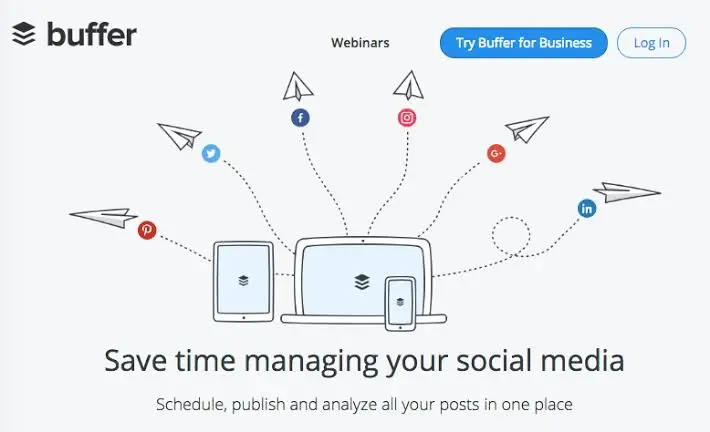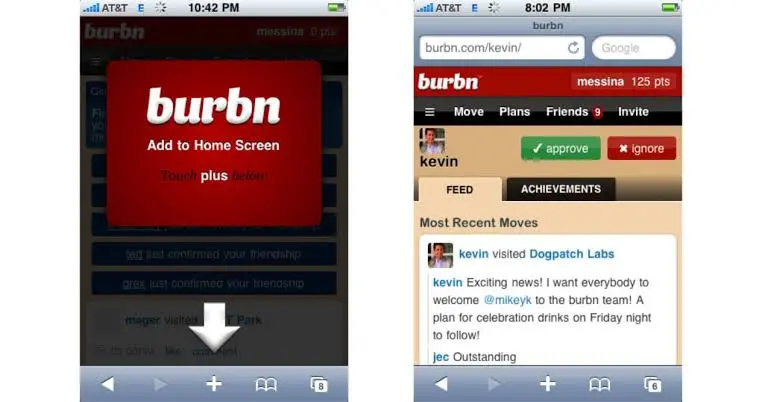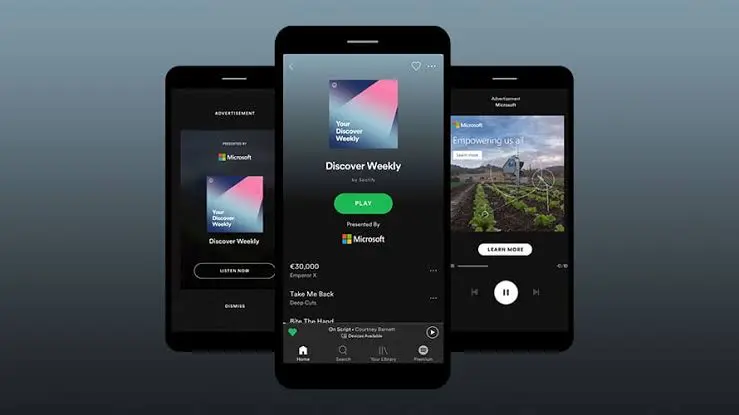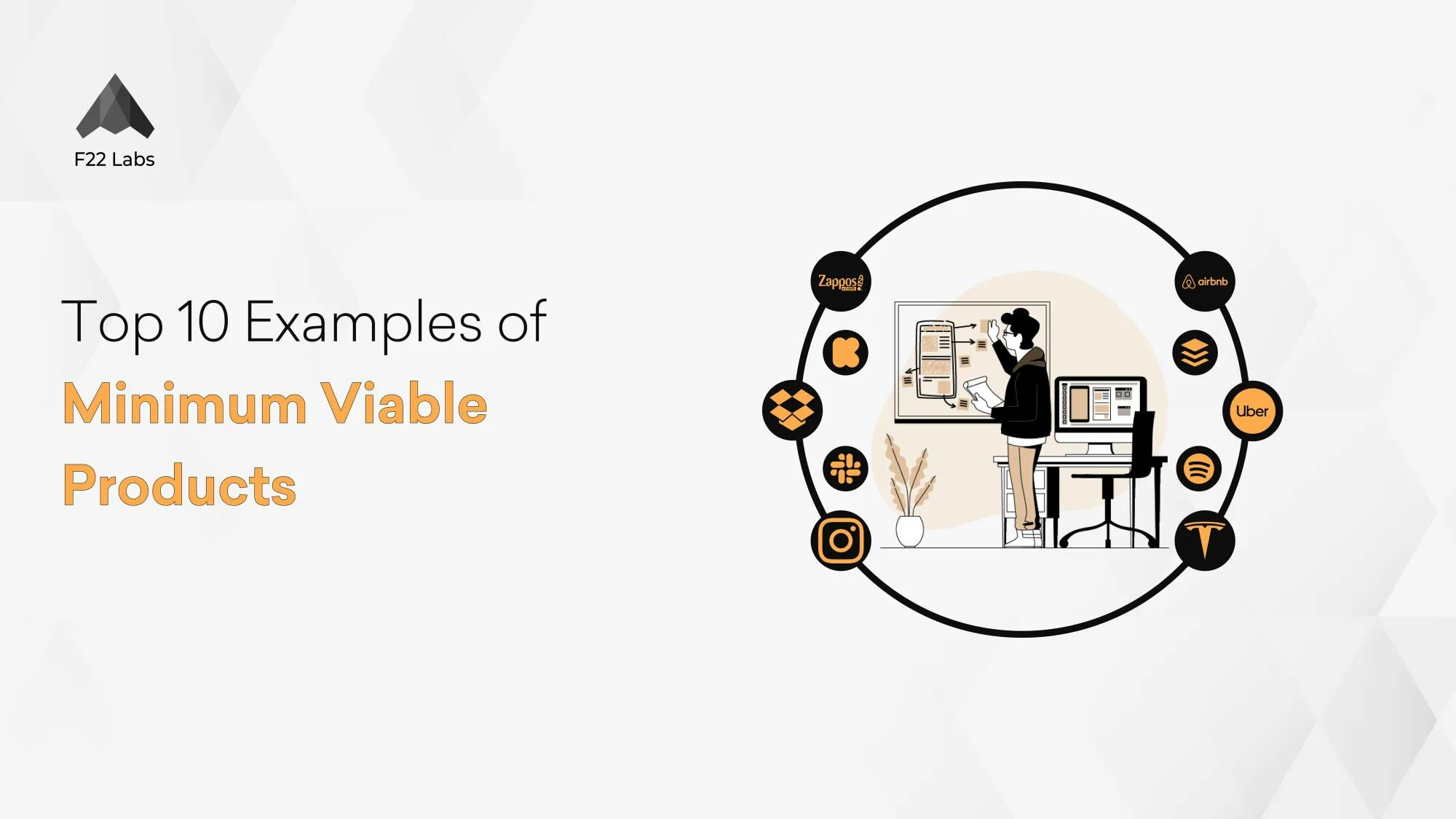Top 10 Examples of Minimum Viable Products
Ever wondered about the secret behind the early successes of many tech giants? The surprising answer lies in the power of starting with the bare minimum.
Eric Ries, the pioneer of the Lean Startup movement, famously said,
The minimum viable product is that version of a new product which allows a team to collect the maximum amount of validated learning about customers with the least effort.
His words highlight the essence of the Minimum Viable Product (MVP), a central tenet in the startup universe. According to a report, approximately 64% of features in a typical app are rarely or never used, which underscores the importance of starting lean. This is where minimum viable product examples come into the picture.
Keep reading as we present the top 10 minimum viable product examples, demonstrating how each of them began as MVPs and eventually morphed into products that have significantly impacted their respective markets.
These MVP examples range from technology platforms to social media giants, and each has a unique story to tell about MVP development for startups.
What is the Minimum Viable Product (MVP)?
An MVP, or Minimum Viable Product, is a version of a new product that allows a team to collect the maximum amount of validated learning about customers with the least effort. It's the most basic version of a product that still delivers value to customers.
Essentially, it's about starting small, learning fast, and scaling appropriately. For entrepreneurs, understanding MVP examples and product mvp examples can be a game-changer in their startup journey.
Compilation of the Best 10 Minimum Viable Product Examples
MVPs play a crucial role in product development. They help in validating assumptions about the market and user behavior, save time and resources, and reduce risks associated with product failure.
These MVP product examples provide a way for startups and large companies alike to test their ideas without investing too much time and money into something that may not work. MVPs form the foundation of MVP software development examples and are key to agile MVP examples.
What are the Examples of Real MVPs?
MVPs play a crucial role in product development. They help in validating assumptions about the market and user behavior, save time and resources, and reduce risks associated with product failure.
These examples of MVPs provide a way for startups and large companies alike to test their ideas without investing too much time and money into something that may not work. MVPs form the foundation of software development and are key to your growth and by understanding these startup MVP examples you’ll get a clear picture on planning for the evolution of your product.
Example 1: Dropbox
Kicking off our list of minimum viable product examples is Dropbox. It started as a basic file-syncing service and its MVP was nothing more than a simple video demonstrating how the product would work. This was an innovative approach to an MVP KPIs (key important points) showcase.
|
Key Features |
The MVP of Dropbox was successful because it effectively communicated the potential of the product. The reaction to the video was overwhelmingly positive, demonstrating a clear market need. The company was able to build an impressive waiting list even before the product was fully developed.

Dropbox's success and impact on the market have been profound. As of April 2023, the company boasts over 700 million users and is valued at approximately $8.28 Billion.
Example 2: Airbnb
Airbnb, another heavyweight in our roster of minimum viable product examples, was born out of necessity. Its co-founders, struggling to pay rent, decided to rent out their living space to attendees of a local conference.
They set up a simple website, "Air Bed and Breakfast," where they listed their apartment as a bed and breakfast. This was the humble MVP for what would become Airbnb.

Unique Selling Points and Value Proposition
The unique selling points of Airbnb's MVP were:
Authentic local experiences: Airbnb provided a platform for homeowners to rent out their spaces, offering travelers a more unique and local experience than traditional hotels.
Affordable accommodations: The service catered to budget-conscious travelers looking for more affordable lodging.
Community-driven: Airbnb fostered a community of users who could rate and review each other, creating trust among its user base.
The value proposition of Airbnb was simple and attractive:
For guests: Offering a wide range of affordable accommodations with the opportunity to experience local living.
For hosts: Enabling homeowners to monetize their unused spaces.
Growth and Disruption in the Hospitality Industry
Airbnb revolutionized the hospitality industry. Its user-friendly platform and community-focused approach caught the attention of travelers and homeowners alike. The company's growth has been staggering.
By the end of 2022, Airbnb boasted over 4 million hosts and 6.6 million listings worldwide. The impact of this MVP product example on the hospitality industry is undeniable, causing hotels to rethink their business models.
Example 3: Zappos
Zappos, another classic from our minimum viable product examples, was initially a risk-averse MVP. Founder Nick Swinmurn, unable to find a pair of shoes he wanted in a mall, envisaged a better solution.

He started Zappos as a simple website displaying pictures of shoes from local shoe stores. When orders came in, he would purchase the shoes from the stores and ship them out, emphasizing an extraordinary customer experience from the very start.
Innovative Features and Business Model
Acquisition by Amazon and Market Expansion
The MVP software development example of Zappos proved that excellent customer service could lead to incredible growth. This did not go unnoticed by eCommerce giant Amazon, which acquired Zappos in 2009 for approximately $1.2 billion.
Post-acquisition, Zappos expanded into clothing, accessories, and other product categories. Today, Zappos has millions of customers and continues to prioritize customer service, maintaining its position as a leader in online retail.
Example 4: Buffer
When we think about social media management tools, Buffer readily pops into mind as a reliable and user-friendly platform. But did you know that Buffer, too, began its journey as an MVP? Joel Gascoigne, the co-founder, started Buffer by creating a simple landing page.

The landing page detailed what the product would do—help users schedule their social media posts—and asked interested visitors to sign up. This initial version served as a concrete MVP product example to validate demand.
Core Features and User Feedback-Driven Development
From its MVP stage, Buffer was poised to solve a specific problem—streamlining social media posting. Over time, they built on the feedback received from early adopters to refine and expand the product.
Growth Strategies and Monetization Models
Buffer adopted a freemium model, a strategic move that contributed to its virality. Users could use the basic features for free but had to pay for advanced functionalities.
As they continued to add valuable features and improve user experience, Buffer grew, gaining over 1 million in 2013. Today, Buffer remains a prominent player in social media management tools, further affirming the power of minimum viable product examples.
Example 5: Instagram
Delving into the historical records of Minimum Viable Product (MVP) examples, we find a noteworthy case on Instagram. What is now a social media powerhouse started as a simple app named Burbn, which allowed users to check in, post plans, and share photos.

Key Features and User Engagement Strategies
Kevin Systrom, the co-founder of Instagram, noticed that the photo-sharing feature of Burbn was the most used and loved. He quickly pivoted, stripping Burbn down to a pure photo-sharing app, renamed it Instagram, and gave birth to another notable mvp product example.
Instagram's user base skyrocketed post-launch, hitting a million users within just two months. Its massive success led to the acquisition by Facebook in 2012 for a whopping $1 billion.
Since then, Instagram has continually evolved, introducing features like Stories, IGTV, reels, and Shopping, and transforming from one of the best examples of MVP to a comprehensive social media platform.
Example 6: Kickstarter
Kickstarter has made its name as a popular crowdfunding platform, helping bring creative projects to life. But this platform, too, started as an MVP. Perry Chen, the founder, built Kickstarter to validate the demand for a crowdfunding platform that helps creators secure funding for their projects.

Platform Features and Initial Success Stories
Kickstarter's features were straightforward and user-friendly, offering a win-win situation for creators and backers.
Kickstarter's impact was immediate and transformative. Kickstarter, as an MVP, was quick to demonstrate its potential, becoming a vital platform for creators needing financial backing to realize their visions. One of the early success stories that propelled Kickstarter into the spotlight was the Elevation Dock.
The Elevation Dock, a high-quality iPhone dock designed to "make docking enjoyable," was introduced on Kickstarter by Casey Hopkins, a previously unknown innovator. The project aimed to raise $75,000. However, the idea struck a chord with tech enthusiasts and Apple product users worldwide, raising a whopping $1,464,706 with the help of over 12,500 backers.
This incredible feat marked one of the first times a Kickstarter project had raised over a million dollars. It signified the platform's potential to transform an idea into a product by harnessing the collective power of individual backers who believed in that vision.
Impact on the Creative Industry
Kickstarter has left an indelible mark on the creative industry. It fundamentally disrupted traditional funding models, providing an alternative for creatives who may not have access to typical financial backing.
Since its launch, Kickstarter has successfully funded over 240,000 projects, raising more than $7 billion from backers worldwide. This triumph makes Kickstarter an inspiring MVP development for startups.
Example 7: Spotify
Among the array of minimum viable product examples, the journey of Spotify, a leading music streaming platform, stands out prominently. This Swedish company took a different approach, launching a fully-featured MVP right from the start.
Yet, their iterative, customer-focused approach to product development places them firmly within the sphere of MVPs.
Spotify's MVP in the Music Streaming Industry
The unique aspect of Spotify's MVP was that it was far from minimal. It was an ambitious effort to tackle a big problem - piracy in the music industry. The founders, Daniel Ek and Martin Lorentzon created an attractive legal alternative for listeners to enjoy music.
The initial product was a desktop client, limited to invite-only users in Sweden, which allowed people to stream an extensive catalog of music.
User-Centric Design and Personalized Recommendations
Spotify understood that their real competition wasn't other music streaming services, but rather the convenience of pirated music.
To compete with this, they adopted a user-centric design, focusing on three key areas:
- Ease of use
- The breadth of the music catalog, and
- Personalized recommendations.
Spotify's ease of use was paramount. The platform was designed to be as intuitive and straightforward as possible. The music catalog, on the other hand, was expansive, featuring songs from numerous genres across the globe.
One of Spotify's most notable achievements was pioneering the personalized music recommendation feature. Their famous "Discover Weekly" playlist, generated using an algorithm based on listening habits, made the listening experience unique and individualistic.

This feature brought a significant edge to one of the wonderful examples of startup MVPs, making Spotify a beloved platform for millions.
Global Expansion and Competition
After validating its MVP and refining its offering in Sweden, Spotify began its global expansion. By the end of March 2023, Spotify boasted 518 million active users and 229 million premium subscribers worldwide. The company's 2020 revenue stood at €7.88 billion.
Despite competition from tech giants like Apple and Amazon, Spotify has managed to hold its own, thanks to its unwavering focus on providing the best possible user experience.
By carefully listening to their users and continually iterating their product, Spotify's journey from app MVP to a global leader showcases the potential of minimum viable product examples.
Example 8: Uber
Uber's MVP is a good example and their story is a classic tale of disruption, demonstrating how a simple app can redefine an entire industry. The inception of Uber is another fascinating addition to the spectrum of minimum viable product examples.
Uber's MVP for Ride-Sharing Services
Uber's genesis was surprisingly modest. The founders, Travis Kalanick and Garrett Camp were simply looking for a better way to hail a cab on a snowy night in Paris.
This personal experience led to the birth of UberCab, an MVP launched in 2010 that connected riders with drivers via a smartphone app.

UberCab was limited to San Francisco and offered luxury cars only. This gave them a limited user base of early adopters, a high-demand market, and affluent customers willing to pay premium prices for convenience.
Disruptive Business Model and User Experience
The Uber story we know today revolves around its disruptive business model, often cited as a key mvp software development example. Uber broke the mold of traditional taxi services by allowing virtually anyone with a car to become a driver. This provided limitless scalability and made rides more accessible and affordable for users.
The customer experience was at the heart of Uber's model. Users could request a ride with a few taps, track the vehicle's arrival, and pay automatically via the app. This seamless user experience, along with its transparent pricing and rating system, helped Uber stand out in a crowded market.
Uber's strategy centered around aggressive growth. They moved swiftly, launching in city after city before competitors could establish a foothold. Uber’s success also spurred competition, with regional ride-sharing services popping up across the globe.
Despite these challenges, Uber remains a leading global player in the ride-hailing market, recently expanding into other areas like food delivery (Uber Eats) and freight (Uber Freight).
Global Growth and Regulatory Challenges
Uber’s success story is as much about its rapid global growth as it is about the various regulatory hurdles it faced. The company’s aggressive expansion saw it spread across hundreds of cities in dozens of countries within a few years.
By the end of March 2023, Uber boasted approximately 93 million active users worldwide and its drivers completed nearly 1.44 billion trips in the second quarter alone.
However, Uber’s journey wasn't always smooth. Their disruptive business model raised eyebrows in many cities, leading to legal battles and regulatory challenges.
Despite these hurdles, Uber’s app MVP example demonstrates how a lean startup can swiftly adapt and pivot to navigate a complex regulatory landscape.
Uber's journey from a simple MVP development for startups to a global tech giant is a testament to the power of MVPs. It is one of the compelling examples of mvp on how a simple solution to a common problem can disrupt an entire industry, create a new market, and become a household name.
As we explore more minimum-viable product examples, it’s clear that MVPs are more than just a bare-bones version of a product.
Example 9: Slack
Another prime example in our catalog of minimum viable product examples is Slack, a hub for team communication and collaboration. The story of Slack's MVP began when a small team of game developers needed a better way to communicate. They built an internal tool that eventually turned into one of the fastest-growing B2B products.

Slack's MVP for Team Communication
Slack was created by Stewart Butterfield while he was leading a team developing a game called 'Glitch'. To streamline communication within the team, they developed an internal tool.

When the game failed to gain traction, they realized that the communication tool they had built had potential as a stand-alone product. Thus, Slack was born as an MVP, initially rolled out to other companies in the tech industry.
It was an instant hit, effectively addressing the pain points of team communication. Instead of relying on the fragmented communication landscape of emails, text messages, and various other tools, teams could now communicate effectively in one place.
This MVP product example made team collaboration more streamlined and efficient, laying the foundation for Slack's global success.
Key Features & Integration Capabilities
Adoption by Organizations and Market Leadership
Since its launch in 2013, Slack has seen massive adoption by organizations worldwide. Its ease of use, robust features, and integration capabilities have made it a favorite tool for team communication and collaboration.
By 2022, Slack had over 18 million daily active users, and over 750,000 companies using the platform.
This MVP software development example has not only led the way in team communication but also transformed the way organizations work. Its focus on reducing email dependency, facilitating real-time communication, and seamless integration with other tools has set new standards in the industry.
Example 10: Tesla
Turning to a completely different industry, let's consider Tesla, a trailblazer in the electric vehicle sector, and another excellent addition to our roster of minimum viable product examples.
Tesla's MVP Approach to Electric Vehicles
Tesla's journey is a fantastic mvp development for startup examples, especially for those targeting ambitious, large-scale projects. Elon Musk and his team at Tesla set out to change the narrative around electric vehicles (EVs).
They wanted to prove that EVs could be better, quicker, and more fun to drive than gasoline cars.
Tesla's MVP was the Roadster, a high-performance electric sports car launched in 2008. Rather than trying to compete with established auto giants in the mass market, they targeted a niche - affluent buyers interested in high-performance, environmentally friendly cars.

Technological Innovations and Sustainability Focus
Tesla's Roadster disrupted the auto industry, not only because it was electric but also due to its impressive performance and range. The Roadster could accelerate from 0 to 60 mph in less than 4 seconds, with a range of 245 miles on a single charge - a significant leap from existing electric cars of the time.
This focus on continuous technological innovation became a key tenet of Tesla's product development philosophy.
Tesla's mission is to accelerate the world's transition to sustainable energy. It isn't just about creating electric vehicles; it's also about creating an entire ecosystem that supports sustainable energy. Tesla's focus on building high-capacity battery plants, investing in solar energy, and developing self-driving technology aligns with this mission.
Market Disruption & Future Prospects
Tesla's disruptive approach, starting with a high-end sports car and gradually moving to more affordable models, has proven successful. As of 2022, Tesla was the most valuable car company globally taking the 9th spot, exceeding the market cap of traditional auto giants like Toyota and Volkswagen.
Tesla's prospects appear equally promising. With the continuous development of more affordable models, expansion into new markets, and a focus on self-driving technology, Tesla is poised to maintain its market leadership.
Final Thoughts
The journey of these 10 companies, all unique app MVP examples, illustrates the power and importance of MVPs in product development.
It's crucial to note that an MVP isn't just a basic version of your product but the start of a journey. A journey of understanding your users, their needs, the market landscape, and, importantly, your product.
"The best way to predict the future is to create it," said Abraham Lincoln. This quote fits perfectly when it comes to developing a Minimum Viable Product (MVP). It's about creating a future for your ideas, for your vision, and ultimately, for your business.
F22 Labs is here to help you take that first step. We understand that launching a startup can be overwhelming, and that's why we offer a tailored approach for every entrepreneur, every idea, and every MVP.
We believe in your ideas, and we have the resources and expertise to transform them into practical, market-ready products. Whether you are in the ideation stage or ready to hit the market, F22 Labs can guide you through every step of your journey.
Don't let your ideas just be ideas. Turn them into action, turn them into products, turn them into reality. Contact us today for a free 1-hour consultation.
Let's create the future together.
Author Detail
Murtuza Kutub
A product development and growth expert, helping founders and startups build and grow their products at lightning speed with a track record of success. Apart from work, I love to network & Travel.
Let's work together
Next for you
The Role of AI in Software Testing
Quality Assurance Testing
AI in software testing can be used to improve and expedite the testing procedure. Testing with the help of AI assesses a software's functionality, effectiveness, and dependability by automating data validation, error detectio...
The Fusion of AI and Automation Testing: Revolutionizing QA
Quality Assurance Testing
In the field of physics, fusion is a process where the smallest components of atoms are forced to join together, creating a new atom and releasing an immense amount of energy. Similarly, we are combining AI (the new cool gu...
Boost Site Engagement with Dynamic Open Graph Images in Next.js
Technology
In today’s digital landscape, Open Graph (OG) images play a crucial role in enhancing the visibility and appeal of your web content when shared on social media. This blog explores the implementation of dynamic OG images using...
